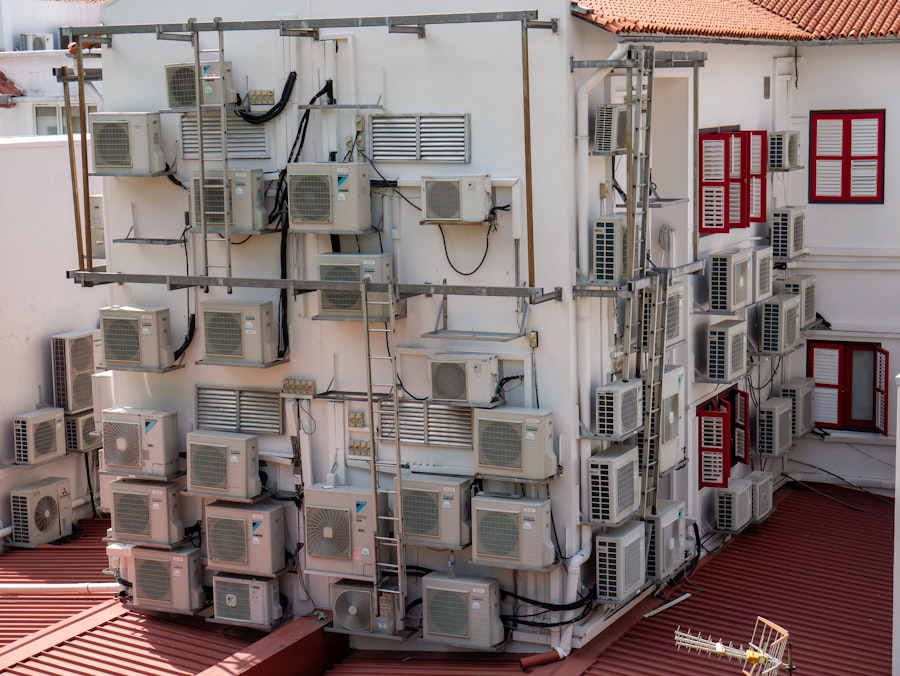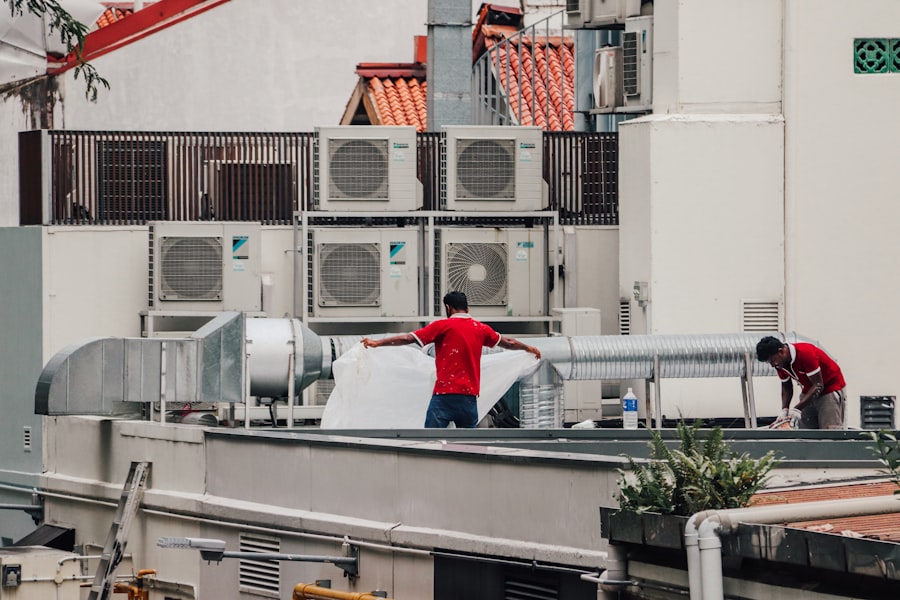Air conditioning systems are intricate machines that require a basic understanding of their components and functions for effective repair. At the heart of an air conditioning unit lies the refrigeration cycle, which involves the evaporation and condensation of refrigerant to transfer heat from inside a building to the outside environment. This cycle is facilitated by several key components, including the compressor, condenser, evaporator coil, and expansion valve.
Each part plays a crucial role in ensuring that the system operates efficiently and effectively. Familiarity with these components can significantly aid in diagnosing issues when they arise. Moreover, air conditioners can be categorized into various types, such as central air conditioning systems, window units, and ductless mini-splits.
Each type has its own unique set of challenges and repair techniques. For instance, central air systems often involve complex ductwork and require knowledge of airflow dynamics, while window units are more straightforward but may present challenges related to installation and drainage. Understanding these distinctions is essential for anyone looking to delve into air conditioner repair, as it allows for a more tailored approach to troubleshooting and fixing problems.
Key Takeaways
- Learn the fundamental components and functions of air conditioners for effective repair.
- Recognize common issues like airflow problems, refrigerant leaks, and electrical malfunctions.
- Regularly clean and maintain air filters to ensure optimal performance.
- Troubleshoot thermostat problems to maintain accurate temperature control.
- Know when to seek professional assistance for complex or unsafe repairs.
Identifying Common Air Conditioner Problems
Recognizing the signs of common air conditioner problems is the first step toward effective repair. One prevalent issue is inadequate cooling, where the unit fails to lower the indoor temperature to the desired level. This can stem from various causes, including dirty filters, malfunctioning thermostats, or refrigerant issues.
For example, if the air conditioner is running but not cooling effectively, it may indicate that the evaporator coil is frozen due to restricted airflow or low refrigerant levels. Identifying these symptoms early can prevent further damage and costly repairs. Another frequent problem is unusual noises emanating from the unit.
Sounds such as grinding, squealing, or rattling can indicate mechanical issues that require immediate attention. A grinding noise may suggest that the motor bearings are worn out, while a squealing sound could point to a slipping belt or a failing fan motor. Rattling noises might be caused by loose components or debris within the unit.
Understanding these auditory cues can help homeowners pinpoint issues before they escalate into more significant malfunctions.
Checking for Airflow Issues

Airflow issues are among the most common problems encountered in air conditioning systems and can significantly impact performance. One of the first steps in diagnosing airflow problems is to inspect the air filters. Clogged or dirty filters restrict airflow, leading to reduced efficiency and potential system failure.
Homeowners should regularly check and replace filters according to manufacturer recommendations or more frequently if they have pets or live in dusty environments. A clean filter allows for optimal airflow, ensuring that the system can cool effectively. In addition to filters, ductwork should also be examined for blockages or leaks.
Ducts can become obstructed by dust, debris, or even pests, which can hinder airflow throughout the home. Leaky ducts can lead to significant energy loss and uneven cooling in different areas of the house. Conducting a visual inspection of accessible ductwork and using techniques such as smoke pencils or thermal imaging can help identify leaks or blockages.
Addressing these issues not only improves airflow but also enhances overall energy efficiency.
Addressing Refrigerant Leaks and Low Levels
| Metric | Description | Typical Range | Importance |
|---|---|---|---|
| Leak Rate (%) | Percentage of refrigerant lost per month due to leaks | 0.5% – 5% | High – Indicates system efficiency and environmental impact |
| Refrigerant Charge Level (lbs or kg) | Amount of refrigerant currently in the system | Depends on system size (e.g., 5-30 lbs) | Critical – Ensures proper cooling performance |
| Pressure Drop (psi or bar) | Difference in pressure indicating potential leaks | 0 – 5 psi typical; higher indicates leaks | Medium – Helps detect leaks early |
| Leak Detection Frequency | How often leak inspections are performed | Monthly to quarterly | High – Regular checks prevent major losses |
| Repair Time (hours) | Average time to locate and fix leaks | 1 – 4 hours | Medium – Minimizes downtime and refrigerant loss |
| System Efficiency (%) | Cooling efficiency before and after leak repair | 80% – 100% | High – Reflects impact of leaks on performance |
Refrigerant is a critical component in the cooling process of an air conditioning system. If there is a refrigerant leak or low refrigerant levels, the system will struggle to cool effectively. Signs of refrigerant issues include ice buildup on the evaporator coil, hissing sounds near the refrigerant lines, or a noticeable increase in energy bills without a corresponding increase in usage.
It’s essential to address refrigerant problems promptly, as they can lead to compressor failure if left unchecked. To address refrigerant leaks, it is crucial to first locate the source of the leak. This often requires specialized tools such as electronic leak detectors or UV dye kits that can help pinpoint leaks in the system.
Once identified, repairs may involve replacing damaged components or sealing leaks in the refrigerant lines. After repairs are made, it’s necessary to recharge the system with the appropriate type and amount of refrigerant as specified by the manufacturer. Handling refrigerant requires caution and adherence to environmental regulations, as improper handling can lead to harmful emissions.
Dealing with Electrical Malfunctions
Electrical malfunctions are another common issue that can affect air conditioning systems. These problems can manifest in various ways, such as tripped circuit breakers, blown fuses, or unresponsive thermostats. A tripped breaker may indicate an overload in the electrical circuit or a short circuit within the unit itself.
Homeowners should first check their electrical panel for any tripped breakers and reset them if necessary. However, if breakers continue to trip after resetting, it may signal a deeper electrical issue that requires professional attention. Additionally, wiring problems can lead to intermittent operation or complete failure of the air conditioning unit.
Loose connections or frayed wires can disrupt power flow and cause components to malfunction. Inspecting electrical connections for signs of wear or damage is essential for maintaining system reliability. In some cases, it may be necessary to replace faulty wiring or components such as capacitors or contactors to restore proper function.
Given the potential hazards associated with electrical work, homeowners should exercise caution and consider consulting a qualified technician for complex electrical repairs.
Handling Thermostat Problems

The thermostat serves as the control center for an air conditioning system, regulating temperature settings and ensuring comfort within a home. When issues arise with the thermostat, they can lead to improper cooling or heating cycles. One common problem is inaccurate temperature readings due to dirt buildup on sensors or improper placement of the thermostat itself.
If a thermostat is located near heat sources like windows or appliances, it may not accurately reflect the room’s temperature, leading to inefficient operation. Another issue could be related to compatibility between the thermostat and the HVAC system. For instance, if a homeowner upgrades to a smart thermostat without ensuring compatibility with their existing system, they may encounter operational problems.
Troubleshooting thermostat issues often involves recalibrating settings, replacing batteries in battery-operated models, or even upgrading to a more compatible unit if necessary. Ensuring that the thermostat is functioning correctly is vital for maintaining energy efficiency and comfort levels within a home.
Cleaning and Maintaining Air Filters
Air filters play a pivotal role in maintaining indoor air quality and ensuring efficient operation of an air conditioning system. Over time, filters accumulate dust, pollen, pet dander, and other particulates that can obstruct airflow and reduce efficiency. Regular cleaning or replacement of filters is essential for optimal performance; many manufacturers recommend checking filters monthly and replacing them every three months at minimum.
In homes with pets or high dust levels, more frequent changes may be necessary. Cleaning reusable filters involves rinsing them under water until all debris is removed and allowing them to dry completely before reinserting them into the unit. Disposable filters should be replaced according to manufacturer guidelines.
Neglecting filter maintenance not only affects cooling efficiency but can also lead to increased wear on system components due to restricted airflow. By prioritizing filter maintenance, homeowners can enhance their air conditioning system’s longevity while improving indoor air quality.
Seeking Professional Help for Complex Issues
While many air conditioner repairs can be handled by knowledgeable homeowners, some issues require professional expertise due to their complexity or potential safety hazards. Problems such as compressor failure, extensive refrigerant leaks, or significant electrical malfunctions often necessitate specialized tools and training that most homeowners do not possess. Attempting to tackle these issues without proper knowledge can lead to further damage or even pose safety risks.
Professional HVAC technicians bring valuable experience and diagnostic tools that allow them to accurately assess and repair complex problems efficiently. They are trained to handle refrigerants safely and are familiar with local regulations regarding HVAC repairs. Additionally, many technicians offer maintenance services that can help prevent future issues by identifying potential problems before they escalate into costly repairs.
For homeowners facing persistent issues or those unsure about their ability to perform repairs safely, seeking professional assistance is often the best course of action for ensuring reliable air conditioning performance.




